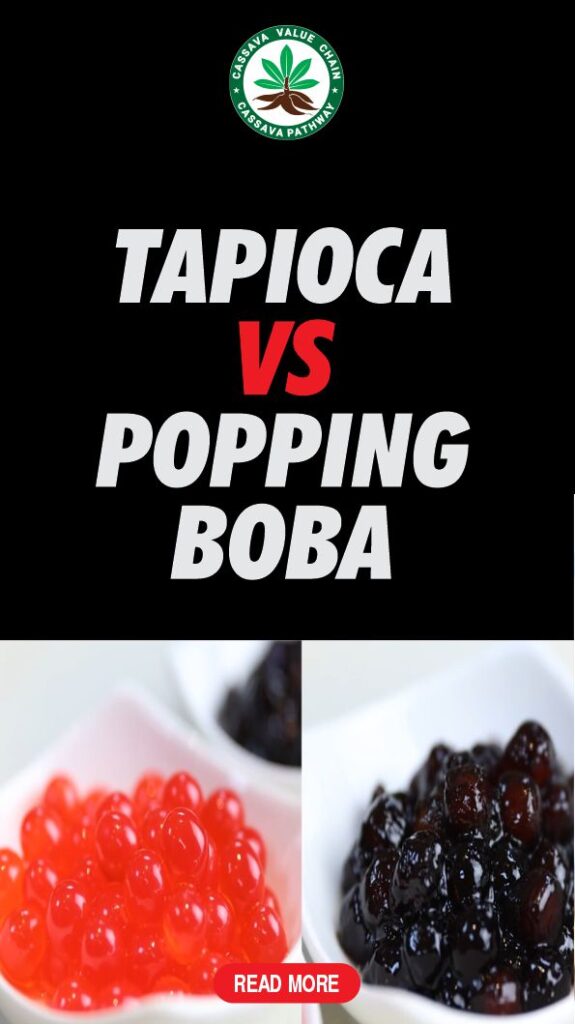Tapioca vs Popping Boba: Which one suits your drink? Discover the key differences in texture, taste, and uses to choose the best boba for your bubble tea or dessert!
You’ve probably had bubble tea before, but did you pay attention to what’s at the bottom of your cup?
Some drinks come with chewy black pearls, while others have colorful balls that pop in your mouth.
That’s the difference between tapioca boba and popping boba.
They might look similar, but they’re completely different in taste, texture, and how they’re made.
People often confuse them because they both add a fun texture to drinks and desserts.
If you’re wondering which one is better or which one you should choose, this guide breaks it all down.
Related: What is Tapioca?

Table of Contents
- What is Tapioca Boba?
- What is Popping Boba?
- Tapioca vs Popping Boba: Differences
- Can You Substitute Tapioca for Popping Boba?
- Which One Should You Choose?
- Conclusion
What is Tapioca Boba?
Tapioca boba, also called tapioca pearls, is made from cassava starch. It was first introduced in Taiwan and quickly became a popular ingredient in bubble tea.
- Origin: Tapioca comes from the cassava plant, which is processed into a fine starch. This starch is then shaped into small balls. Traditionally, they are black due to caramel or brown sugar added during cooking, but they can also be white or pastel-colored.
- Texture: Chewy and soft with a slight elasticity. The more you chew, the sweeter it gets if it’s soaked in syrup.
- How it’s made: Tapioca pearls start as small, dry beads that need to be boiled. They’re then soaked in sugar syrup to add sweetness and maintain softness.
- Common uses: Mostly found in bubble tea but also used in desserts like puddings and shaved ice.
Recommended: Tapioca vs Arrowroot
What is Popping Boba?
Popping boba is a modern creation that’s completely different from tapioca pearls. It’s made using molecular gastronomy and adds a unique twist to drinks and desserts.
- Origin: Unlike tapioca boba, popping boba isn’t plant-based. It’s made using a chemical process called spherification, which creates a thin, gel-like outer layer with a burst of liquid inside.
- Texture: Delicate and smooth. It pops the moment you bite into it, releasing juice.
- How it’s made: A mixture of fruit juice and sodium alginate is dropped into a calcium bath, causing a reaction that forms a thin outer shell while keeping the inside liquid.
- Common uses: Popping boba is popular in bubble tea, frozen yogurt, fruit teas, cocktails, and desserts. Unlike tapioca pearls, it doesn’t require cooking and is ready to use straight from the package.
Related: Tapioca vs Rice Pudding
Tapioca vs Popping Boba: Differences
Now that you know what each type of boba is, here’s how they compare:
- Source: Tapioca pearls come from the cassava root, while popping boba is made from fruit juice using sodium alginate.
- Texture: Tapioca is chewy and soft, while popping boba has a thin outer layer that bursts with liquid.
- Taste: Tapioca is neutral in flavor and needs to be sweetened, while popping boba is already flavored and juicy.
- Preparation: Tapioca pearls must be boiled and soaked in syrup, while popping boba is ready to eat.
- Storage & Shelf Life: Tapioca must be consumed quickly, or it hardens. Popping boba has a longer shelf life and can be stored in the fridge for weeks.
- Caloric & Nutritional Differences: Tapioca is high in carbohydrates and contains little to no nutrients. Popping boba has fewer calories but contains sugar from the fruit juice and added syrup.
- Appearance & Colors: Tapioca pearls are dark brown or black, but can also be white. Popping boba comes in bright colors like red, green, yellow, and orange, matching its fruit flavors.
Related: Tapioca vs Cornstarch
Can You Substitute Tapioca for Popping Boba?
This depends on what you’re making.
When substitution works
If you just want a fun texture in your drink, you can swap one for the other. In bubble tea, either type of boba works, depending on whether you prefer chewy pearls or juicy bursts.
When it doesn’t work
Some recipes require a specific texture. If you’re making traditional bubble tea, replacing tapioca with popping boba won’t give the same experience.
Likewise, tapioca won’t work in frozen yogurt or fruit-based drinks where the juicy burst of popping boba enhances the flavor.
Best recipes for each
Use tapioca pearls for classic milk teas and warm desserts. Use popping boba for fruit teas, cocktails, or ice cream toppings.
Further Reading: Tapioca vs Cassava:
Which One Should You Choose?
Your choice depends on texture and flavor preference.
- Go for tapioca if: You love a chewy, soft bite that lasts in your mouth. It works best in milk-based bubble tea and warm desserts.
- Pick popping boba if: You prefer an instant burst of fruity flavor. It’s great for cold drinks, frozen yogurt, and fun desserts.
- Different drinks and desserts:
- Milk tea: Tapioca boba
- Fruit tea: Popping boba
- Coffee-based drinks: Tapioca boba
- Frozen yogurt: Popping boba
- Cocktails: Popping boba
- Traditional Asian desserts: Tapioca boba
Related: Tapioca vs Boba: What’s the Difference?
Conclusion
Tapioca and popping boba may look similar, but they are completely different in texture, taste, and preparation.
Tapioca pearls give a chewy bite, while popping boba offers a juicy explosion.
The right choice depends on what you’re craving and what type of drink or dessert you’re making. Now that you know the difference, which one will you try next?

Chimeremeze Emeh is a writer and researcher passionate about Africa’s most transformative root crop—cassava. Through his work at cassavavaluechain.com, he explores the entire cassava industry, from cultivation and processing to its diverse applications in food, health, and industrial use.
He also writes for palmoilpalm.com, where he shares his extensive experience and deep-rooted knowledge of palm oil, covering red palm oil, palm kernel oil, and refined products. His work there reflects his lifelong connection to agriculture and his commitment to promoting sustainable value chains in Africa.
Driven by curiosity and purpose, Chimeremeze aims to shed light on how cassava continues to empower communities, strengthen food systems, and link traditional farming wisdom with modern innovation.

